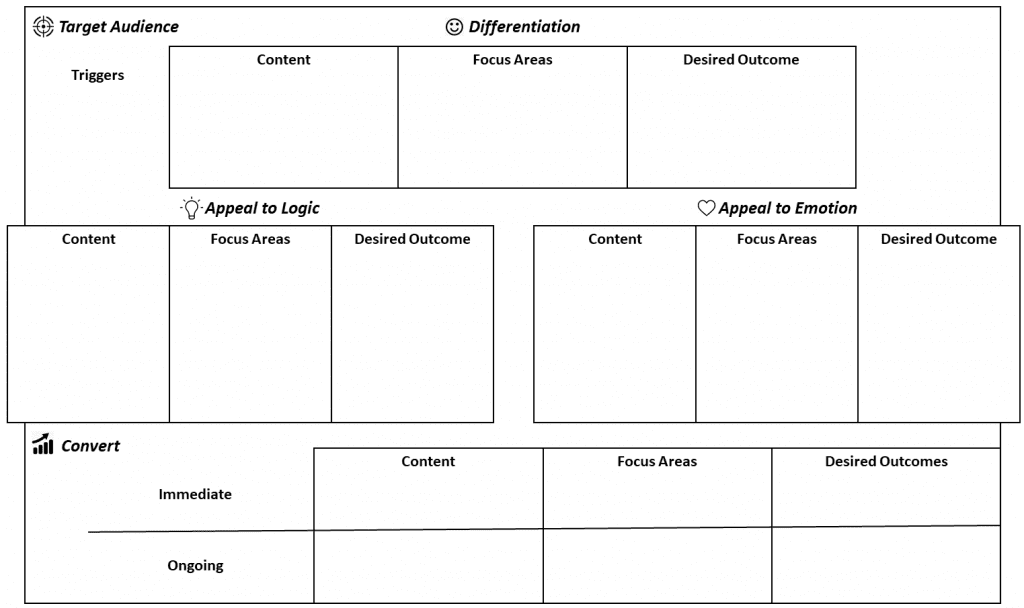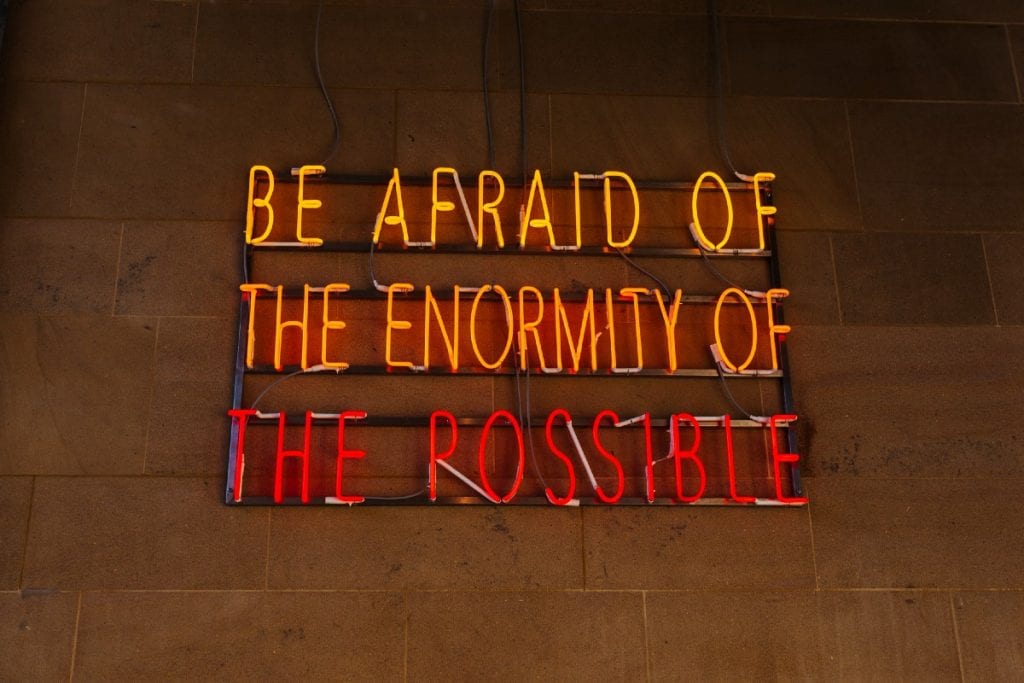Part One: Creating Digital Experiences People Care About
To China, With Love
Since this is the first in a series of articles that introduces the concept of The Marketing Matrix, let me set this up for you. A few years ago a Chinese businessman reached out to me on his trip through the U.S. He was looking for ways to market his “Proudly Made in China” products on Amazon. I wouldn’t consider myself an Amazon sales expert, but I do know how to create marketing and messaging people care about.
After several meetings, he was inspired. But since he was selling a product and not creating much of a brand, he wanted assurances that what we were proposing would work. We showed him research and strategic briefs, but those alone didn’t convince him. We showed him creative ideas and mood boards, but those didn’t either. We modeled his media spend with expected acquisition, conversion and retention numbers, but showing possible numbers wasn’t enough without a guarantee of results—you know, that thing that marketers hate to hear from their clients more than anything.
He pushed us and I appreciate him for it. Because of him I was inspired to come up with a system to “prove” the efficacy of digital experiences we developed—I called it The Marketing Matrix. I took inspiration from other great tools like The Business Model Canvas that were easy to understand and use, but were deceptively powerful. And like The Business Model Canvas, The Marketing Matrix would eventually be applied for businesses of all types and sizes, from innovative startups I mentored at our local HotHouse incubator to North American outreach for the United Nations.
The Red Pill
Having been in marketing agencies a while, I can tell you that a lot of them are broken. I ran a Strategy department once and had some hyper-intelligent staff who developed incredible insights every day. They pored through research data and analytics and presented their SWOTs and deep rationales with dazzle. Our clients were always enraptured by their findings.
But then my Strategists would deliver their reports to our User Experience and Design teams. To my dismay, I found that their hard work was largely disregarded. I never knew if it was just too heady for those teams to comprehend, a matter of ego, or a belief that strategy wasn’t needed in the creative process. Strategy became simply a checkbox to charge a client for. As I peeled back the veneer on other agencies, I saw it was the same there. It was one of those dirty secrets nobody wanted clients to find out about.
So the Chinese businessman got me thinking—could I develop a tool that not only satisfied his requirements for proof, but also fixed this hole in agency process? Could The Marketing Matrix effectively stitch together Strategy and every department that came after them so that no effort (or client money) was wasted? The answer revealed itself as we started working with the tool.
Navigating The Matrix
The Marketing Matrix provides a true user-centric process that keeps target audiences as the focus for every step in the creation of a digital experience. More than that, the tool defragments efforts and makes everyone more efficient by moving logically from high level to high fidelity, from left to right, top to bottom. Strategy talks to Design who talks to Content who talks to Development who talks to Marketing who talks to Analytics—all from a single holistic perspective.

Target Audiences
Prior to creating the matrix, we define audiences by combining supervised machine learning with human intelligence. Our tools ingest millions of real-time data points from all around the web, scouring conversations and influences. AI then identifies patterns, uncovers similar targets, and defines the most valuable microsegments. We then use these findings to create target-rich personas and subpersonas, predicting the most effective content, channel, influencer, and device affinities.
A tool is only user-centric if it drills down to 1:1 recommendations for what will inspire each user type to engage and convert. Every important audience we define is recorded in the header of the matrix. Working on one audience sheet at a time we see the forest and the trees, strategy and tactics, that will engage and convert them. The final step is to scribble down some “Triggers” from our research that will be dissected later and turned into key content and actions in the experience we’re building. Don’t worry about these being perfect from the outset—it’s not unusual to update these later once we’ve worked through our appeals and conversion actions. The rest of The Marketing Matrix is made up of four areas:
Goal
We structure goals at the highest level in two different ways—ENGAGE and CONVERT—because neither can exist without the other. For those of you who are long-time students of advertising, you will recognize that the subsections of each follow the classic AIDA model broken down like this:
Differentiation is the thing that will make you stand out from the crowd. It creates the Attention in AIDA.
Appeal to logic is how we satisfy the left, reasoning side of the brain with data and education. It creates the Interest in AIDA.
Appeal to emotion is how we satisfy the right, creative side of the brain with evocation and passion. It creates the Desire in AIDA.
In the Convert section, we list Immediate and Ongoing because it’s critical to consider both in digital experiences. What do we want people to do right away, and how will we keep them engaged and converting over time? These two create the Action in AIDA.
Most Relevant Content
This area is a summary of what will engage a target in order to satisfy the Goal it is associated with. Determining what this content should be will be spelled out in its own article in this series, but in short comes from insights driven by:
- Comparative and competitive analysis
- Data analytics from your customer information
- Analytics from digital experiences you own like websites and apps
- Real-time interest and vocabulary analysis from social media
- Engagement analysis across media and content types
- Influencer type and topic analysis
Focus Areas
Once we capture what will engage a target, we determine where to put it. Good UX designers will consider Human Computer Interaction (HCI) principles.
These principles help determine where content needs to live to achieve the intended goals and elicit the intended actions:
- How much real estate it needs to occupy
- Where it should be placed
- How it needs to be formatted
- How long it should be
- What context it needs to appear in
Desired Outcome
This is the lynchpin that holds the entire matrix together. If desired outcomes don’t align with their goals, content and placements that come before them, the entire exercise is invalid. This area forces you to look at your priorities from another perspective—the overall business goals of the digital property.
Filling this out can be daunting, but I have a shortcut for you. Look at the AIDA model again and break down each section. The desired outcomes of anything in the Differentiation section, for example, can simply center on driving greater Attention in some way; for Appeal to Logic, the outcomes can focus on generating Interest, and so on.
Finally, it is important to choose outcomes that are measurable wherever possible. In fact, in the advanced version of The Marketing Matrix where we’ve been hired to manage a client’s marketing channels, we add an additional column under Goals entitled “How Measured.” The matrix then becomes a living document to capture successes against prioritized goals, constantly refine our insights, and optimize the overall marketing mix along with all of its associated digital properties.
The Blue Pill

- In searching for a photo for this section I looked for one of a corded phone, but only found cell phones.
- In this prophecy, the web is soon going away, replaced by hyper-targeted personal digital experiences.
- In this obituary, a small community of online gamers shows humanity how we should be taking care of each other.
- Gartner predicts the rise of Neuromorphic Hardware, Human Augmentation and a Brain-Computer Interface in this article.
Each of these point to a quickly developing future that could wind up being dystopian or utopian. That future will be driven somewhat by people like you and me who are creating either more automated AI-driven experiences or more humanistic connecting and inspiring ones.
For businesses blazing their own paths to this future without an innovative agency like mine to guide them, success will come from new frameworks that capture as much as possible about targets’ digital behaviors and require them to apply predictive human insights. Despite a lot of snake oil being sold out there, in the utopian vision of our future that I’m working for, human intervention is still critical in this equation.
This is what The Marketing Matrix empowers you to do. It forces every discipline to come together to produce the most human experience possible, giving you the best possible chance to “prove” it will work for your audiences. How? Through collective human intelligence that machines cannot replicate.
Watch out for more articles on The Marketing Matrix where I dive deeper into each section. In the meantime, you can download it here. I encourage you to use it. Though it looks simple on its exterior, I’m hoping the realities it confronts you with to bring your digital experiences to life keep you awake at night, challenging you to become a better creator.
